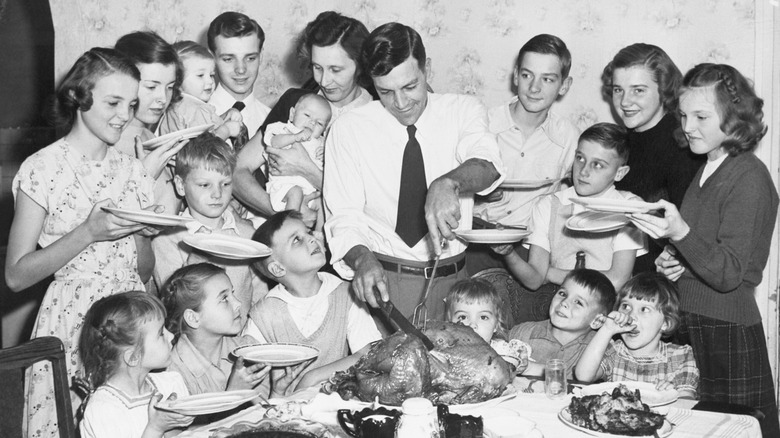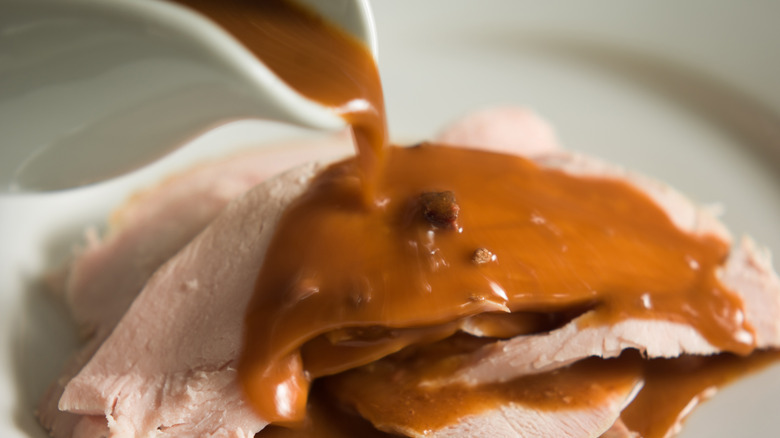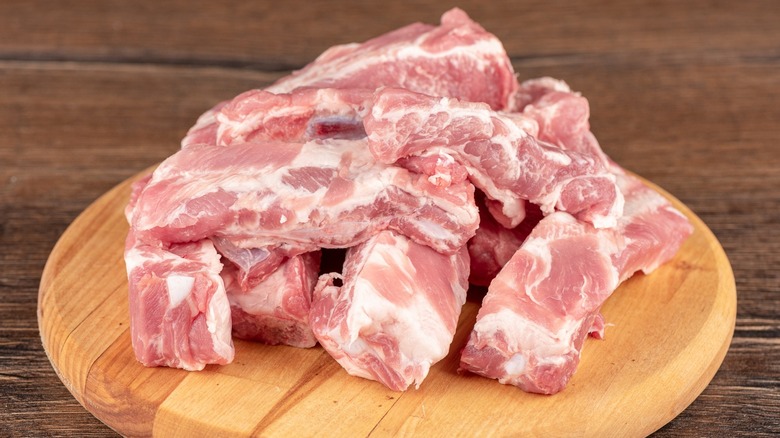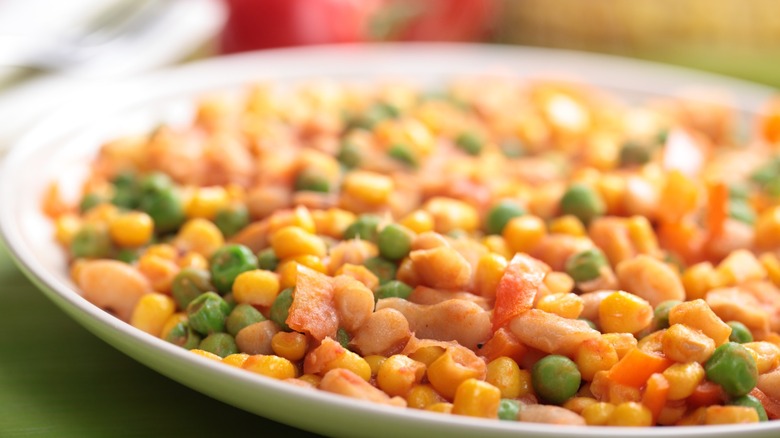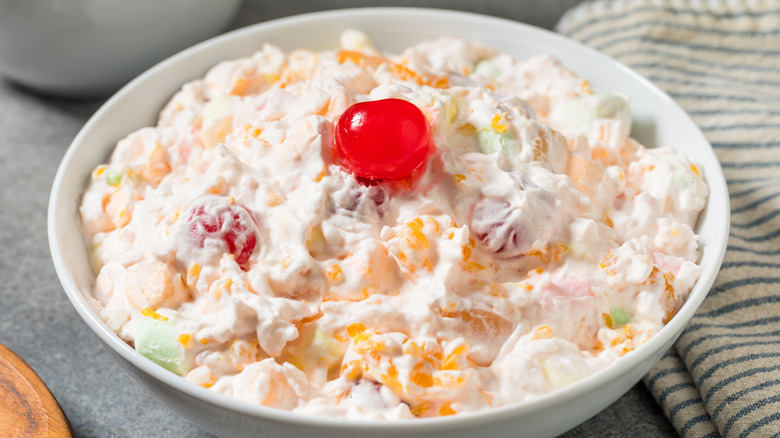Old-School Thanksgiving Dishes People Hardly Make Anymore
There's something about Thanksgiving that makes us crave specific foods every year. More than half of all American households plan to eat turkey, mashed potatoes, and stuffing for the holiday, according to a 2024 YouGov survey. Do we truly love these comfort dishes so much, or could even the most traditional holiday foods one day be forgotten? Considering how many once-popular Thanksgiving dishes have faded from our recipe lists, you could make a case for the latter.
Of course, a range of factors affect trends in eating habits over time. Everything from demographic shifts to culinary fads to economics can impact what Americans serve up for Thanksgiving. That said, there are several old-fashioned and downright odd dishes that are tough to imagine ever sharing space on the table with our beloved pumpkin pie and candied yams. Some may secretly love these controversial side dishes, but we're convinced that most of these foods lasted so long because people were afraid to share honest opinions with the cook. For better or worse, here are some of the most notable old-school dishes that people rarely make for Thanksgiving anymore.
Oyster stuffing
While oysters are now associated with higher-end seafood restaurants, they were once a super-abundant protein enjoyed by the upper and lower classes. Fresh oysters were so common in northeastern cities like Boston during the 1800s that vendors sold them on street corners and in neighborhood saloons. With the fall months being peak time for oyster harvesting, it was only logical to add these chewy mollusks to Thanksgiving stuffing.
The trend spread inland as mass canning improved and helped usher in an "oyster craze" in the 19th century. Even as the oyster population dwindled in the Atlantic, oysters were a common Thanksgiving side into the mid-20th century. However, you now rarely see this fall dish anywhere outside of New England and the Gulf Coast, as many find seafood to be an odd pairing with turkey.
Those who do make it generally use canned or jarred shucked oysters, which tend to have a mild, briny flavor similar to sardines. It's a standard dressing recipe from there, with bread cubes, celery, and onion. Just be sure to sauté everything in oyster oil from the can for extra shellfish flavor. Add oysters liberally and bake in a pan or stuffed inside the turkey.
Giblet gravy
Even though they're packaged with nearly all whole turkeys, giblets are now more like a novelty that most people toss out or, worse, forget to unpack before cooking. Old-school cooks would never throw these internal organs away, as they add earthy flavors to stuffing, broth, and especially gravy. The giblets, which include the turkey's heart, liver, and gizzard, are adventurous dare foods by today's standards. Thus, the waste-not tradition of incorporating them into Thanksgiving cuisine has faded. If you're feeling bold, you'll find the giblet packaged in a bag next to the neck inside the bird's main cavity. Open up the bag, and you've got giblet goodness ready for sautéing.
Giblet gravy is simply a sauce made from simmering the organs with aromatics and mixing in drippings, broth, and milk or flour. It's a surprisingly straightforward cooking process that yields a more flavorful and chunky gravy perfect for topping the bird or making a pool inside your mashed potatoes. Unfortunately, true giblet gravy is becoming rarer as many people are turned off by the organs or prefer the ease of premade or packet gravy. Furthermore, the smaller "oven-ready" turkeys, which don't come with giblets, are becoming more popular.
Turkey aspic
For generations, the solution for excess Thanksgiving leftovers was to cook all the extra turkey in an aspic, a savory gelatin made from meat stock. If the idea of turkey chunks suspended in a slice of murky, jiggly jelly gives you the icks, you're not alone. Most people don't cook aspic anymore unless they're ultra old-school or enjoy creating retro foods.
Aspic is a centuries-old food that originally required boiling high-collagen meats before going through several steps of filtering and reheating the excess fat. The process was so time-consuming that only wealthier households with hired help could manage it. Yet aspic was more than just a status food, as the jelly seals off the inner ingredients from bacteria and acts as a preservative. Aspics increased in popularity during the early to mid-19th century as commercial gelatin products made them much more accessible to a public yearning for congealed food.
To make turkey aspic, simply pour broth mixed with gelatin powder over pulled turkey pieces and let it set in a mold. You could also add in green beans, carrots, or any other leftover veggies your Thanksgiving guests neglected. It's essentially a cold, solidified turkey soup. In fact, if you store a leftover-inspired turkey soup in the refrigerator, you may end up with an accidental aspic — only without the fun mold set.
Thanksgiving pudding
Christmas has figgy pudding, so it's only fair for Thanksgiving to have its own antiquated fruitcake-like dessert. Americans created "Thanksgiving pudding" as an unofficial offshoot of the traditional British Christmas pudding, a sweet sponge that's boiled or steamed. The Fannie Farmer cookbook has a recipe that includes dried fruits, breadcrumbs, walnuts, brown sugar, and a liberal amount of warm spices like cinnamon. It's all held together with eggs and suet, a hard beef fat that melts slowly and acts like shortening.
The suet does not give off a meat flavor, but it does make for a very dense texture. And since it's steamed rather than baked, the result is very moist as well. The flavor can be especially strong if you choose to go traditional and soak the figs, raisins, and currants in rum for a few days and then top the pudding with brandy sauce. Thanksgiving pudding was a boozy dessert alternative to pies for generations, but it's gone out of style like the Christmas pudding. In other words, people see it as an outdated, heavy loaf that's about as welcome at the dinner table as a political discussion.
Mashed turnips
Thanksgiving menus from the 1860s — the decade it became a national holiday — often list mashed turnips just as much as mashed potatoes. Turnips, a starchy root vegetable, were more cultivated in many regions at the time, especially in the Midwest and Northeast. Many families stuck with the veggie as the preferred mashed side even after potatoes emerged as the star companion to turkey.
Making the dish simply requires peeling, boiling, and mashing the turnips with butter and your favorite spices. Some may add parsnips and rutabagas to make a proper root mash. While turnips have a pungent flavor similar to cabbage or radish, they become milder and even a tad sweet after cooking. They're a lighter, lower-carb alternative to potatoes, yet you'll be hard-pressed to find them at even a health-conscious Thanksgiving dinner these days.
Turnips developed a reputation as a food for poor, rural families as potatoes grew in favor. Today, they're more likely to be used for cattle feed than human consumption. Nevertheless, you can still find small batches of turnips at grocery stores if you want to sample an old-school mashed starch.
Pork ribs
As Thanksgiving developed into a widely celebrated feast, families naturally wanted to commemorate the day with a special centerpiece. That often meant preparing pork ribs over the ubiquitous turkey. The mode of thought up until the mid-19th century was that pork ribs were a premium, harder-to-come-by food better suited for special occasions. In those days, true barbecue pork involved slow cooking over a fire, seasoned with just mustard, vinegar, or nothing at all. The sweet sauces we now associate with the cuisine did not emerge until the early 20th century.
However, turkey ultimately took hold in the mid-1800s as the nation's favorite Thanksgiving food for many reasons. While there's no hard evidence that the first Thanksgiving feast included the bird, they're native to North America and were a regular part of the pilgrims' diet. Most turkeys are large enough to feed a crowd, which led to a natural progression into holiday tradition. President Abraham Lincoln reportedly loved to eat them for Thanksgiving, and Charles Dickens featured a famous turkey dinner scene in his 1843 book, A Christmas Carol. Today, roughly 46 million turkeys are eaten every year during the Thanksgiving holiday, while barbecue ribs have been relegated to the Fourth of July.
Jello salad
The jello salad's swift rise in popularity in the 20th century came with an equally fast fall from grace. Unless it's in a kid's snack or college party shot, gelatin is not as popular as it once was due to changing culinary tastes and an aversion to jiggly molds. Still, there was a post-war window of several decades where no Thanksgiving table was complete without a colorful congealed ring. These concoctions often featured fruits and whipped cream, straddling the line between side dish and dessert.
Other old-school recipes crossed over into more bizarre territory, combining sugary mixes with veggies and nuts. Some scary examples included the Perfection Salad (lime gelatin with pineapple, cabbage, and celery) and Red Crest Salad (strawberry gelatin with tomatoes and pickles). And then there were the layered trifle salads, which would combine different colored mixes with creamy sections made from the likes of cottage cheese, Cool Whip, or mayonnaise.
When powdered gelatin went mainstream in the early 1900s, it was a scientific breakthrough that cut down on the previously time-consuming process of making congealed jelly with animal fat. Brands like Jell-O and Knox were also affordable, making them a popular dish for Thanksgivings during the Great Depression and other times of economic unease. Today, jello salads are more of a retro cooking punchline than a genuine side dish.
Succotash
Originating from Native American fare that existed before colonists arrived, succotash has a long connection to Thanksgiving. The name is an Anglicized take on msíckquatash, a Wampanoag word that refers to boiled kernels of corn. Indigenous Americans in the Northeastern Woodlands would cook it with beans and animal fat in a stew big enough for feasting. Some say the dish may have been served at the first Thanksgiving in 1621.
In the centuries since, succotash spread down through the Mid-Atlantic and South, often prepared with lima beans, tomatoes, and squash in a colorful mix. The side dish was especially popular during tough economic times, as it was affordable and easy to assemble with canned veggies. For holidays, you could go the extra savory mile with a succotash recipe that includes cooked onions, bacon, and broth.
In recent years, succotash has seen a resurgence as a celebration of fresh summer produce. This makes Thanksgiving a bit late for peak corn and tomato season, and thus it's hardly ever included in the menu now. Furthermore, a bowl full of veggies is a tough sell when guests are clamoring for classic starches like mashed potatoes, rolls, and stuffing.
Ambrosia
Ambrosia was the food of the gods in Greek mythology, said to support immortality and divinity. At Thanksgiving, it's just another old-fashioned dish no one wants to see at the table. The mortal version of this sweet salad includes fresh or canned pineapples and oranges mixed with marshmallows and coconut. Depending on what the maker has in the fridge at the time, ambrosia could also include whipped cream, nuts, and additional fruits like grapes and strawberries (and a maraschino cherry on top). It's best to let it sit overnight to achieve that sweet flavor meld that immediately evokes the 1950s.
While it may seem like a close relative to a cream pie or creamy fruit salad, ambrosia is a polarizing dish that garners dirty looks when served to guests at holiday parties. The earliest known recipes date back to the 1860s, with it being especially popular in the American South. The dish grew in popularity in the post-war years as canned fruits and packaged marshmallows went mainstream. Ambrosia's squishy texture and hodge-podge nature eventually established a nostalgic reputation, but not in a cool, vintage way. If you're old enough to remember this dish, you probably also remember force-feeding yourself bites to appease your family.
Mincemeat pie
A hallmark of old-fashioned food is a cavalier attitude toward mixing meats and sweets. Case in point is mincemeat pie, which was traditionally filled with beef, apples, dried fruit, and cider. That flavor combination was so strange that bakers started dropping the meat in the 1800s, and the pie eventually became a holiday favorite. Mincemeat pie remained popular enough into the 20th century that Bon Appétit featured the dessert in its 1974 Thanksgiving menu alongside Waldorf salad and roast turkey with cornbread-sausage stuffing. That recipe, which called for eight varieties of dried fruit, recommended soaking the filling in rum for two days to get the proper liquored flavor.
While spiked desserts like boozy ice cream have gained popularity in recent years, mincemeat pie has turned from holiday classic to forgotten dessert. A big factor in its ultimate exclusion from party appearances is the confusing moniker. No matter how often you tell people it's meatless, the name alone is enough to turn off some guests. Plus, dried fruit has lost cachet over the years. If your options on a Thanksgiving dessert platter include one pie stuffed with raisins and another filled with pumpkin puree, we know which you're going to choose.
Cranberry souffle
As a native fruit to North America that's harvested in the fall, cranberries were a practical food inclusion at the first Thanksgiving. The tradition has evolved over the years with the advent of the canned sauce, which you can simply plop out in all its ridged glory or incorporate into some more inventive sides. One such creation was cranberry souffle, which rose to prominence in the '50s from a Hellmann's-promoted recipe. While this was a marketing gimmick to get people to add mayonnaise to their Thanksgiving shopping list, it had some staying power. This souffle strikes a middle ground between ambrosia and jello fruit salad, but with the tartness of cranberry.
The recipe calls for blending nuts, orange slices, and a can of cranberry sauce into a heap of mayonnaise-infused gelatin. Simply let it chill for a bit in your favorite mold, and voilà — a "fit companion for a holiday turkey," according to the original advertisements. As anyone who has tried a slice of cranberry sauce straight from the can knows, it can be quite tangy on its own. The mayo is a surprisingly good pairing that brings the tart-sweetness down a level while adding a bit of creaminess. Unfortunately, the recipe has faded as Hellmann's has found new ways to market, but many people have fond memories of their grandmothers making this side dish.
